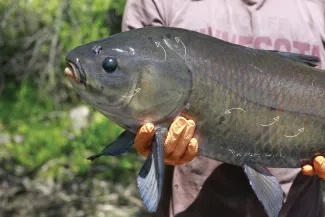
A study of bigmouth buffalo in Minnesota waters revealed the fish can live much longer than originally expected.
A 112-year old bigmouth buffalo from Minnesota blew maximum age estimates for the species out of the water, so much so that the bigmouth buffalo became the oldest age-validated freshwater fish.
The supercentenarian fish was collected as part of a North Dakota State University study, and more than quadrupled a previous maximum age estimate of 26 years. That estimate was based on an Oklahoma State University analysis of six bigmouth buffalo collected in the Keystone Reservoir near Sand Springs in 1998. The OSU team shared its findings in a paper titled “New Maximum Age of Bigmouth Buffalo,” but the authors also included their belief that many bigmouth buffalo populations may have fish older than 20 years, the maximum age estimate prior to their study.

Bigmouth buffalo are one of 16 species of “sucker” fish that can be found in Oklahoma. Unlike other suckers, which tend to have downturned mouths and feed on the bottom, the bigmouth buffalo is primarily a filter-feeding fish. In Oklahoma, it is thought to occur in most larger rivers and reservoirs in the eastern half of the state. This individual was collected by the Wildlife Department’s Fisheries Division from Grand Lake.
In this more recent study, the North Dakota State University team collected and aged 386 bigmouth buffalo from Minnesota waters from 2016 – 2018. Ages of those fish, including the 112-year old individual, were determined by a count of the annual growth bands on one of the fish’s three pairs of otoliths, or earstones. In addition, 28 otolith samples were used to test whether the otolith annulus counts were accurate. This was done via bomb radiocarbon dating, a particular type of carbon-14 dating. The presumed otolith annulus counts were indeed thoroughly accurate, as they were validated not only cross-sectionally among individuals, but also longitudinally within individuals. The five oldest fish in the study were all more than 100 years old, and many of the populations studied are dominated by fish more than 80 years old.

Annual growth bands on this thin section image of an otolith, or earstone, were used to age a 23.6-pound female bigmouth buffalo collected in Minnesota waters. This fish was 81 years old. White dots indicate years, green dots indicate decades.
The study’s authors also had a hunch that bigmouth buffalo develop black and orange markings as they age. So, in addition to examining the fish’s earstones, the North Dakota State University team also looked at individual fish’s body markings to see if pigmentation could give clues about the fish’s age. Of the study’s fish, the markings were almost never found on fish younger than 32, yet were almost always present on fish older than 45. Black markings are thought to be obtained from sun exposure over time, and orange spots are thought to result from the fish’s diet, both environmental factors that can be influenced by water quality.

Black and orange markings, which may be a result of sun exposure and diet, may provide clues to a bigmouth buffalo’s age. Markings are indicated with white arrows.
Finally, the North Dakota State University team estimated the reproductive maturity of bigmouth buffalo. Forty-four of the study’s fish were examined for this objective; 14 were male while 30 were female. The onset of sexual maturity was estimated at 5 – 6 years for males and 8 – 9 years for females, but may have been underestimated for females. This finding contradicts previous studies of the species that indicated bigmouth buffalo may reach maturity as early as the first year of growth.
Not only does this study shatter our perceptions of bigmouth buffalo longevity, it also shows that the fish mature at a later age than previously thought, and suggests that age classes may not reproduce each year. Another study in North Dakota confirmed that bigmouth buffalo exhibit what is called “episodic” or irregular recruitment, and that it is related to environmental conditions. The fish have occasional years of spawning success separated by periods of poor reproduction for a decade or more. They also found that in North Dakota, the onset of sexual maturity is 6 years for males and 10 years for females. As a large-bodied and long-lived species with few natural predators, this slow-paced life history strategy is considered a suitable one. The new life history information on bigmouth buffalo, and similar data specific to Oklahoma, can help biologists better understand and collect further data to manage this species, and other species like it, in Oklahoma.
Check out the Communications Biology article for more of the study’s details and to see an image of the earstone used to age the 112-year old fish.
2019 was a big year for buffalo news! Three weeks before the North Dakota State University study was published in late May 2019, an Oklahoma angler caught his own record-breaking buffalo. Hugh M. Newman caught a 66-pound female smallmouth buffalo from Broken Bow Reservoir. This new Oklahoma record was estimated to be 62 years old, and is thought to be the oldest reported smallmouth buffalo.